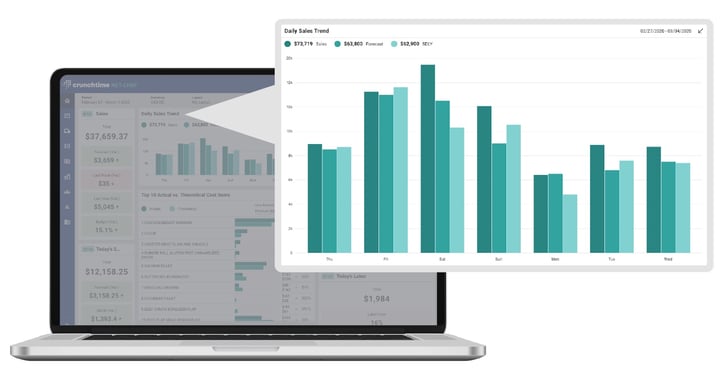
- Home
- Crunchtime Blog
- 10 Signs You've Outgrown Your Restaurants' Scheduling Vendor

10 Signs You've Outgrown Your Restaurants' Scheduling Vendor
Many restaurants don’t realize they’ve outgrown their scheduling software until it becomes overdue. Look out for these 10 telltale signs.
When restaurant brands start to scale and add more store locations, it is common to feel growing pains with their tech stack. What you thought was the best restaurant scheduling app, may no longer serve your operation well. Or perhaps, your current vendor over-promised on functionality, and now you’re left spending your time creating manual workarounds for a process that should have been automated.
In today’s challenging operating environment, there’s no room for software to hold you back. But changing vendors is a major decision. You need to be confident in your decision to migrate platforms and understand the risk versus the reward. As you evaluate your current technology providers, it’s important to understand what is holding you back from growth.
10 signs you’ve outgrown your restaurant scheduling software:
- Increased support ticket wait times, or issues that go completely unresolved
One of the most glaring signs that your current scheduling software is no longer sufficient is if you begin to experience longer wait times for support tickets or encounter issues that remain unresolved for extended periods of time. The restaurant industry is fast-paced, and there's little time to deal with ongoing support issues or platform reliability. These disruptions can quickly hinder your operation, leading to inefficiencies and frustrated staff. - The relationship doesn’t feel like a partnership
If you find that the relationship with your current provider feels one-sided or lacks collaboration, it is likely they can no longer meet your needs. You should always have a primary point of contact at the organization that can help answer your questions, or point you to the best place for resolution when an issue arises. You should also consider how you provide feedback to your vendor. Do they have a process for you to submit new ideas or provide input on the current product capabilities? Your technology providers should be actively listening and collecting your feedback to improve the product. If the product roadmap isn’t based on the actual needs of restaurants like yours, they are likely out of touch with the current needs of the industry. - The system can’t integrate with your other platforms
Your scheduling software should seamlessly integrate with other platforms, like HRIS and payroll. If you cannot integrate seamlessly, there’s a strong chance for data discrepancies and overall inefficiencies. Restaurants today are using more technology providers than ever before. If your systems cannot talk to each other, you may find that you’re creating more problems than solutions in your operation. - Your software cannot keep up with your reporting needs
As your brand grows, so do your reporting needs. Your scheduling software should provide comprehensive reports that offer insights into your labor costs, employee performance, labor law compliance, and scheduling trends. Reports should also be easily generated at the store-level, regional level, and nationwide to give complete visibility into the operation. If your current software falls short of meeting these reporting requirements, or if generating reports is a cumbersome and time-consuming process, it may be time to explore alternative solutions. - Forecasting is manually intensive and inaccurate
Your sales forecast is foundational to your restaurant’s ability to optimize labor and control labor costs. If building the forecast is a long, convoluted process that involves multiple disparate systems, this will impact its quality and even impact whether your managers choose to use it at all. As managers build schedules, the forecast should be clearly visible so they can use it to inform their decisions. If you have to pull the forecast from an outside software or switch screens back and forth, you’re wasting valuable time. If the forecast itself is regularly inaccurate, you’re not going to be positioned for any sort of successful labor optimization in your stores. In many cases, bad forecasts are a byproduct of having very limited customization options. This means that the inputs of the forecast are very rigid and cannot account for different scenarios like special events, or the demand of the drive-thru throughout the day. Oftentimes, managers will quickly stop using a forecast altogether if they feel it is inaccurate or unhelpful. That means you're paying for a service that no one is using. - You lack the ability to customize staffing templates to your stores’ needs
Staffing level templates (or staffing matrix) are critical drivers for proper restaurant scheduling. They can easily be the difference between an optimally staffed shift and an insufficiently staffed shift. In multi-unit restaurant operations, stores often have different labor needs. If you use the same basic staffing matrix for every store, you will likely run into limitations. Instead, opt for flexible staffing level templates that allow you to schedule for fixed labor or variable labor. To ensure you are staffed to meet demand throughout the day, you should be able to customize your templates to the number of staff needed for breakfast, lunch, and dinner shifts. As an added bonus, you could even define staffing levels within the store for areas like your drive-thru, pick-up counter, dining room, or patio. If you can't tailor your staffing templates to the unique labor demands of each store location, it will become increasingly difficult to schedule your labor correctly. - You’ve created manual workarounds because the system can’t accommodate your needs
If you’ve created a slew of manual workarounds, you’re not operating from a sustainable standpoint. Manual processes are prone to human error and busy restaurant managers can't spend endless time on scheduling. Unfortunately, manual workarounds are quite common, as many scheduling vendors tend to over-promise and under-deliver. This can leave restaurant brands with a bad impression of their technology vendors and make it difficult for them to evaluate new solutions with an open mind. Take note of the areas where your scheduling platform lacks functionality. When you're ready to evaluate new scheduling solutions, request a customized demonstration that shows exactly how the new platform can meet your needs. - Absence of real-time data or reliable data
In today's fast-paced restaurant environment, having access to real-time and reliable data is critical for making informed decisions. If your scheduling software fails to provide data in real-time or if you encounter inconsistencies in the information it provides, you can't make data-driven decisions. Timely data on your labor costs and daily sales should be readily available for managers, down to the 15-minute interval. If you are waiting hours, or even days to see your sales stats, it is impossible for managers to make real-time staffing decisions on the store floor. Remember, you can't manage what you don't have visibility into. Trustworthy data is the foundation of an efficient operation and you can't achieve sustainable growth without it. - Your labor costs are rising, and you feel a lack of control
Labor is a variable cost that is influenced by different factors, making it incredibly challenging for busy restaurant managers to control. A robust scheduling solution should put you in control of your labor costs, by providing the right tools for creating optimized schedules and managing labor on the store floor. This requires an accurate forecast and scheduling alerts that can guide the manager around overtime and labor law compliance. Pay careful attention to the insights your vendor provides when it comes to monitoring and controlling costs because it can greatly influence your future profitability. - Your platform doesn’t support labor law compliance at the local, state, or federal level
Labor laws and constantly changing and staying compliant is essential for avoiding costly penalties and legal issues. If your scheduling software does not support labor law compliance at the local, state, or federal level, it puts your restaurant at risk. Complex laws like Fair Workweek add another level of complexity for operators, but a comprehensive scheduling solution should handle all necessary labor rules. Growing restaurant brands need a platform that offers features such as automatic scheduling alerts for overtime, meal, and rest break compliance, and built-in tools for managing scheduling restrictions and regulations specific to your location.
What to do next?
Recognizing the signs that you've outgrown your restaurant scheduling software is the first step toward ensuring a sustainable, profitable operation. When your operation is regularly faced with long support ticket times, unresolved issues, or a lack of partnership from your software provider, it's evident that your current solution may no longer align with your needs. Your restaurant scheduling software should be the catalyst for smooth shifts, optimized schedules, and controlled labor costs.
In short, the right software should make everyone’s lives easier and make your operation more efficient.
By investing in a more robust and scalable solution that meets your evolving needs, you can better position your restaurant brand for long-term growth. If your restaurant's scheduling solution isn't living up to expectations, or you've outgrown the platform, let's get in touch.
Explore a better scheduling platform.
Find out how Crunchtime helps top restaurant brands create optimized and compliant schedules. Request a demo, and our team of experts will guide you through a personalized demo of the Crunchtime platform—just click below to get started.
Share this post
Related


8 Essential Restaurant Reports for Your Dashboard in 2024



